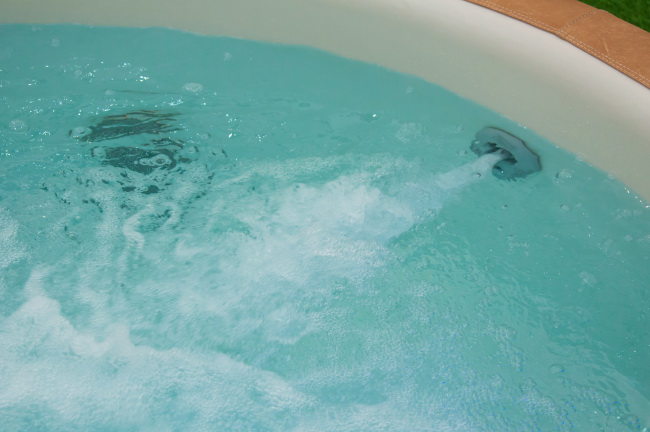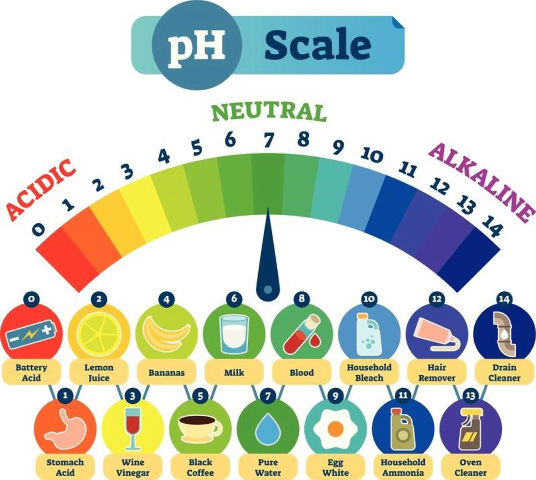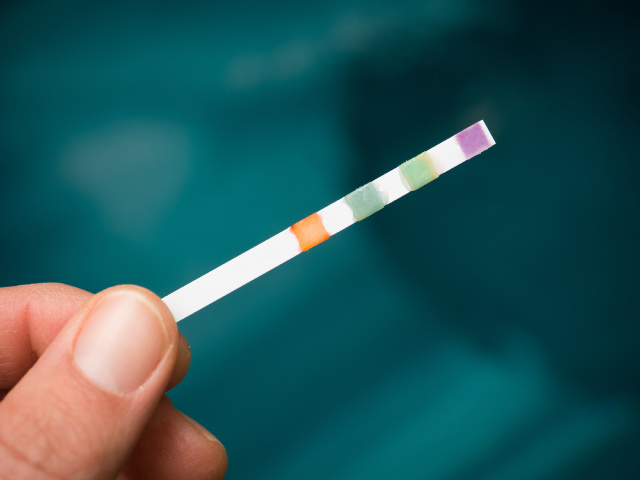Your hot tub should be a fun place to chill and disentangle from the day’s troubles. But if your pH is low in your hot tub it could be a danger to your family’s health and the health of your hot tub.
So how do you raise your hot tub’s pH?
To raise the pH level of a hot tub, add 1 tablespoon of soda ash per 100 gallons (450 L) of water. Run the pump for 1 hour, retest the water and repeat if pH is still low. Baking soda can be used for small pH increases. Use 1 tablespoon of baking soda per 100 gallons (450 L) of water.

Article Contents
The Highs and Lows of pH in Hot Tubs
Your hot tub is a source of fun and relaxation, and not something else to add to your worries. A low pH in hot tubs can not only lead to hardware issues but can impact your family’s health. With that in mind, how do you know if your hot tub has low pH levels?
What are the Signs of Low pH in Hot Tub?
You are ready for some fun and frolicking, but when you remove the hot tub cover the water is foamy? Unfortunately, this is not a good thing! Foamy water is only one sign of low pH in your hot tub. Here are a few more:
- Itchy and Dry skin
- Burning eyes
- Cloudy water
- Scaling
- Burning in your nose
Do you know the difference between pH levels and total alkalinity?
What is Total Alkalinity?
Total alkalinity sounds like how you might end up after a few too many drinks. But it actually means the capacity that a solution has to buffer or neutralize acids.
When we talk about water balance, total alkalinity or TA will always be your starting point. Without the right TA, you will find adjusting your hot tub pH level difficult.
The first, and most important step to a well-balanced hot tub pH, is achieving the optimal TA before adding any other chemicals.
Related Reading: What is Total Alkalinity in Pools | pH vs Alkalinity
Ideal Hot Tub Total Alkalinity
100 parts per million to 150 ppm is your goal. Start with small doses of alkalinity increaser or decreaser, and circulate before retesting.
When you have stable and optimum total alkalinity levels, start testing your pH levels. It is often the case that by getting your TA levels in range, your pH levels ‘auto’ adjust without you having to add any other chemical.
What is Considered Low pH in a Hot Tub?
If you had chemistry at school, you may remember (pH) Potential Hydrogen quantifies the acid and alkaline levels of your tub’s water according to the pH scale. The higher the number, the more basic your water, and lower numbers mean higher acidity.
So, what are the Optimum pH Levels for your Hot Tub?
Neutral water has a pH of seven, and for your hot tub water to be at optimal levels, it is great to keep the pH between 7.4 and 7.6.

Hot tub water with a pH level below 7.2 is considered to be low. And it doesn’t take rocket science to tell us that acid is bad for humans, and for your hot tub’s components. What other damage can low pH does:
- Surface corrosion
- Corrosion damage to components
- Skin and eye irritation
- Dry and itchy skin (Acidic water strips the natural oils from your body)
Unchecked corrosion will cause dissolved substances and debris to cloudy the water, and can even cause a foam build-up. Learn why this happens.
What Causes Low pH in Hot Tubs?
You have seen the signs and symptoms of low pH in your hot tub, and you need to get it sorted. I reckon that the best place to start with anything is to identify the cause of your problem. Here is a checklist of what to check when you have a low pH in your hot tub:
Natural Contaminants
All contaminants in your spa or tub can cause the pH to be unbalanced. These include:
- Grass and Mulch – consider a pathway, or get the kiddos to take a rinse before hopping in.
- Rain – a hot tub cover can assist.
- Sweat, etc. – a shower before helps.
- Insects and dust.
- Food or Drink – wine or beer to relax is great, but food and drink are no fun for pH levels.

Fill Water and Acid Rain
If you get your water from a well or other natural source, then it’s possible this water will not be of ideal pH. Additionally, acid rain can cause low pH levels in your Jacuzzi or hot tub.
Heavy Usage
The more you use your hot tub, the more contaminants you’ll get in the water like an accumulation of:
- Body oils
- Shampoo and soap residue
- Sunblock
- Saliva
- Hair fibers
- Urine
Sanitizers and Other Chemicals
The busier your hot tub, the faster your sanitizers are used up, causing pH to lower. Likewise, when you ‘shock’ your hot tub, your pH will fall.
Related Reading: Low PH in Pool: How to Raise
Why is Low pH Bad for Hot Tubs?
By now it should be clearer than your cloudy hot tub water that a low pH is not good news for hot tub owners. I have touched on the causes and signs of low pH in hot tubs, but why is a stable chemical balance important:
- Hot tub damage
- Etched surfaces
- Shell damage – cracks and delamination
- Metal – railings, light-fittings, etc. are great tucker for acidic water
- Equipment damage – circulating low pH water through the pump, filter, and pipes can cost you a fair amount. Repairs are expensive, and usually, the whole system needs replacing
- Harmful to humans
- Fades color from your budgie smuggler and other swimwear
- Causes stinging eyes
- Gives itchy skin
- Irritates your lungs and nasal passages
None of these issues are good for you, or your hot tub health, and should be addressed as soon as possible.
Chemicals to Raise Hot Tub pH
There are three common chemicals you may have heard of used to raise pH in a hot tub:
- Soda Ash (Sodium Carbonate)
- Baking Soda (Calcium Carbonate)
- Borax (a Borate product)
There is some confusion about Soda Ash vs Baking Soda, these should be used for two different purposes.
Soda Ash is best for making large pH increases. Whilst baking soda is used to raise alkalinity whilst minimally increasing the pH. In the end, the choice will be yours, and the situation you (and your hot tub) are in. Let’s look at both these methods.
You’ll find that Soda Ash is usually labeled “pH Increaser” or “pH Up” when you look in a pool or hot tub supply store. Similarly, Baking Soda is often labeled as “Alkalinity Up” or “Alkalinity Increaser”.
A less common chemical to raise pH is Borax. This will help stabilize the pH and get it to where it needs to be.
Related Reading: Soda Ash or Baking Soda for Pool | Which is Better?
How To Quickly Raise the pH in a Hot Tub with Soda Ash
Soda Ash (Sodium Carbonate) is the go-to method if you need a quick fix to your low pH problem. Why? With a pH of 11.4, it drastically raises the pH and it also increases the total alkalinity.
Now that you have bought your soda ash (sodium carbonate) and JNW Testing Strips, what do you do next?
- Suit pools and spas
- Tests 7 things including chlorine, bromine, pH, cyanuric acid
- Quick & easy to use
1. Turn Off the Pump & Test Water
Turn off all pumps and jets before you test the water with:
- DPD Testing kit (drop test or liquid test kit)
- Test strips
- A digital testing device that checks both the pH and TA levels.
2. Measure the Soda Ash
There is no set rule for the amount you need as it will depend on your pH level. The pH scale is not linear. Generally, you can use a tablespoon of soda ash to 450 liters of water.
Use the less is more principle to avoid overdosing on your tub.
3. Mix, then Add the Soda Ash
Soda ash can cloud the water if you add it directly. To reduce the chances of cloudy water, dissolve it in a bucket of water first before SLOWLY pouring it into your hot tub.
4. Turn on the Pump and Leave for 1 Hour
Put your feet up and let the pumps circulate for about 60 minutes.
5. Retest the Water & Repeat (if necessary)
It’s important to retest the water after adding soda ash. If the pH is too low, add a little more soda ash. If the pH is too high, you can reduce it with muriatic acid or sodium bisulfate.

Related Reading: What Order Should You Add Chemicals in a New Hot Tub? A Hot Tub Start-Up Guide
Step-by-Step Instructions – Using Baking Soda to Raise Hot Tub pH
Baking soda (Sodium Bicarbonate) is another chemical that you can use to increase hot tub pH.
Although it does increase the pH of your hot tub, it will not increase it very much. Unless you’re using a very large amount, which you shouldn’t do. It’s usually used to increase total alkalinity.
Use baking soda if your alkalinity is low and you want to raise it without raising the pH too much.
1. Turn Off the Pump & Test Water
Turn off the pump and jets and check the TA and pH levels
2. Measure the Baking Soda
As with the previous method, this is not an exact science, and the same rule of measurement applies (1 tablespoon to 450 liters of hot tub water).
Remember, you’re best to raise alkalinity and pH in small amounts. It’s best to avoid overshooting. Trial and error will help you find the right balance needed for your hot tub volume.
3. Mix, Then Add the Baking Soda
Diluting the baking soda in a bucket will assist with easier dispersion. SLOWLY pour it in.
4. Turn on the Pump and Leave for 1 Hour
Put your feet up and let the pumps circulate for about 60 minutes.
5. Retest the Water & Repeat (if necessary)
It’s important to retest the water after adding soda ash. If the pH is too low, add a little more baking soda or soda ash. If the pH or total alkalinity is too high, you can lower it by adding muriatic acid or sodium bisulfate (dry acid) to the water.
Does Low pH in Hot Tub Cause Foam?
As mentioned earlier, a foamy hot tub doesn’t mean the Baywatch girls (or guys if you like) are getting ready for a foam party, but it’s more likely caused by a low pH.
Can You Raise pH in Hot Tub Naturally?
You’ve tested the hot tub water and the pH is a bit low. Do you need pool chemicals to increase it?
You can increase the pH level a little with a method called aeration. Just turn on your jets and over a few hours, your pH will naturally rise. If your pH is extremely low, this won’t work.
Another way to naturally increase pH in your tub is to drain some of the water and then refill using water from your tap. Domestic water is typically more alkaline than what your hot tub requires, so some fresh H2O could be all you need to give the pH the lift it needs. You’ll need to rebalance the water with sanitizer and likely need to adjust the total alkalinity if you do this way.
How Much Soda Ash to Raise the pH of Hot Tub?
The amount of soda ash you need to raise the pH of a hot tub does vary. Since the pH scale is logarithmic, the around required is based on the tested pH and the alkalinity level.
Start with the following:
1 ounce of Soda Ash for every 500 gallons of hot tub water.
How Much Baking Soda to Raise pH of Hot Tub?
Again, there’s no set amount of baking soda to raise the pH of a hot tub. The amount you will need depends on the pH level at the time of testing and the alkalinity level.
It’s best to use a pool chemical calculator like this one, look at the instructions on the pack or use this basic rule of thumb.
1 ounce of Baking Soda for every 500 gallons of hot tub water.
Related Reading:
Do You Need to Shock Hot Tubs?
How to Shock a Hot Tub
Can You Fill a Hot Tub or Spa with Well Water?
How to Raise Alkalinity in Hot Tub (Alkalinity is Low)
Soda Ash vs. Baking Soda for Hot Tub: Which is Better?
Chlorine Vs Bromine for Hot Tubs (Which is Better?)
Does Adding Chlorine Change Pool pH Level?
How to Lower pH in Hot Tub (pH is Too High)


